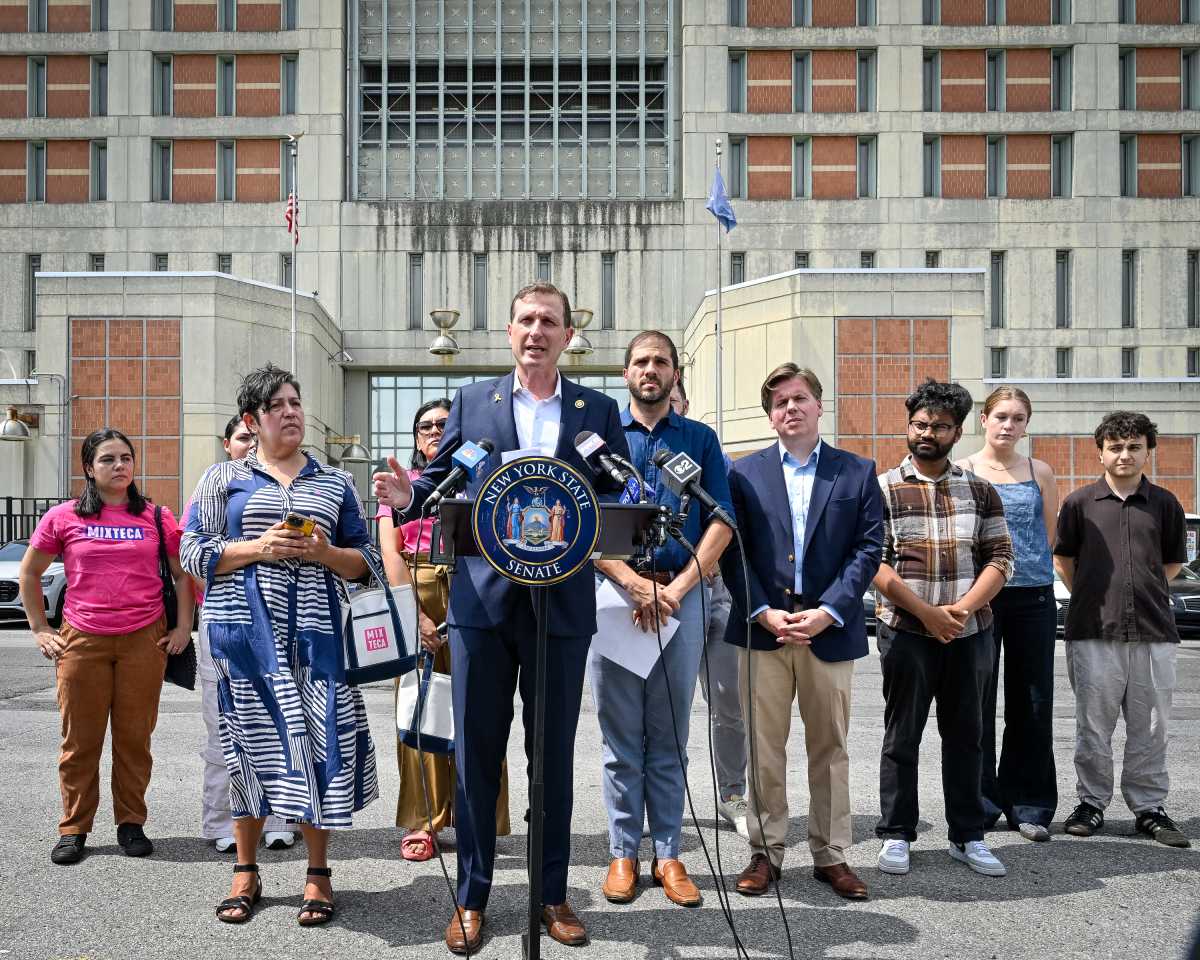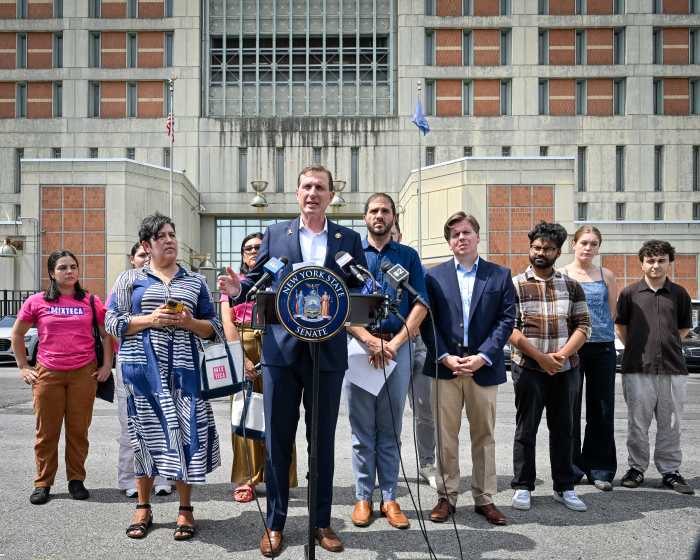By David H. Katz
As New Yorkers recover from their saffron megadose of Christo and Jeanne-Claude, it might well be instructive to consider the work of another energetic, world-spanning artist who has also imposed his personal aesthetics on both natural landscapes and public spaces, creating a body of environmentally interactive, often site-specific events and performances, though of a decidedly different social, political and moral tone; namely, Spanish-born painter, sculptor and performance artist Angel Orensanz.
Internationally known, particularly in Europe, for more than 40 years, Orensanz has produced a richly nuanced, highly personal art ranging from large and complex abstract sculptures in materials as varied as glass, ceramics and metal, to representational works on paper, to large-scale environmental installations in rural and urban settings, to highly theatrical performance pieces, all documented in photographic and video images. Prolific, expansive and a peripatetic world traveler, Orensanz brings an indefatigable vortex of energy and somewhat shameless self-promotion to all of his many and varied productions. Since the late ’70s he has been on a personal odyssey of imagination and visual poetry that has taken him to more than a dozen countries for exhibits, installations and what he has called “interventions,” all while maintaining an extraordinary base of operations on the Lower East Side.
In 1986, at perhaps the nadir of the Loisaida’s long decline, Orensanz purchased an abandoned neo-gothic synagogue at 172 Norwalk St., which had originally been designed in 1849 for a congregation of Reformed German Jews by the Berlin architect Alexander Seltzer. When it opened in 1850 it was the largest synagogue in America, an extraordinarily ornate and beautiful structure modeled on the Cologne cathedral and inspired by the German romantic movement of Beethoven and Heinrich Heine. When Orensanz rediscovered the old synagogue, it had been systematically looted and vandalized for well over 10 years. Orensanz and his brother, Al Orensanz, a New York University sociologist, broke down the building’s cinder-blocked entrances, sealed a network of tunnels and cul de sacs used by junkies to elude the police, and each other, and gradually began to renovate the space, transforming it at first a studio for Angel, which then evolved into a public/private space known as The Angel Orensanz Foundation Center for the Arts.
Since its formal establishment in 1988, The Foundation has housed numerous art and film festivals, presentations, lectures and happenings, foreign and domestic, featuring artists, filmmakers and musicians, such as Cindy Sherman, Spike Lee, Philip Glass, Alicia Keys and Bang On A Can; and the weddings, bar mitzvahs, sundry cocktail parties and other catered events that have helped fund the building’s upkeep, as well as Angel Orensanz’s multiplicity of international projects, much the way Christo’s drawings serve as a source of revenue for his art.
However, unlike his far more celebrated Bulgarian counterpart, who early in his career took possession of a singular, and rather narrow corpus of aesthetic interest involving wrapping, concealment and envelopment, Orensanz has been something of a stylistic chameleon, conducting an expansive, exuberant exploration of multiple, at times sometimes vague, ill-defined and quirky themes and motifs. Working in a romantic, rather than a conceptualist tradition, he also acts theatrically, as a metaphysical vaudevillian, a character in his own drama, “intervening,” imposing or juxtapositioning his own work, and at times, himself, on or against the existing natural world, or oppressive social, moral or political orders. Since the late ’90s, he has brought this strategy to bear on established cultural and political icons, in a series of signs and gestures that become both self-referential and universal.
Consider “The Shattered Tent,” a movable installation of poles and tattered fabric protesting the ruinous war in Kosovo, and the plight of refugees in East Timor, Chechnya and elsewhere. Conceived as an “intervention” posited between impotent governmental organizations and an apathetic, compassion fatigued public, in March 1999 Orensanz first installed it in front of the European Parliament in Strasbourg, France; he then moved it to Geneva, then Brussels, then finally to New York, where it was placed, appropriately, in front of the United Nations.
That December, Orensanz continued the themes of occupation, displacement and cultural ruin nation when he was at the Florence International Biennial where a city bus was transformed into an antiwar installation the press dubbed “The Peace Bus.” Orensanz filled it with bronze chiming sculptures and piled the top of the bus with suitcases — the refugee’s portable home — in various states of disrepair.
Along with fire, which has often figured in his installations and his personal ritualistic performances, another symbol Orensanz has adopted is the sphere, in the form of a large, half-transparent, man-sized, partially painted orb that Orensanz pushes or propels from inside, or suspends, raises, lowers or merely appears with at various venues and in different contexts as he travels around that larger sphere known as the globe. “All things move in perfect circles,” said Aristotle, who postulated a universe of spheres.
Orensanz has propelled his plastic sphere through the Piazza San Marco in Venice, loading it onto a gondola and gliding with it around the canals; floated with it down the Rhine and pushed it up to the transept of the Cathedral of Cologne, the inspiration for his own building at 172 Norwalk St.; has placed it, at times with himself inside, in Florence, and at the Brandenburg Gate in Berlin, and slowly and reverentially guided it down the ramp to where the World Trade Center once stood in Lower Manhattan, a commemoration known as “Experience and Memory From Ground Zero.” All of these activities as well as performances in Tokyo and at the Venice Biennale are chronicled in “Spheroid Memories,” a 25-minute video documenting Orensanz’s Sisyphean odysseys.
At once penetrating and perplexing, and both personal and universal, Orensanz’s art is driven by the force of his personality, memorable for the persistence of its theatrics and remarkable for it its evocation of the collective memory.






























